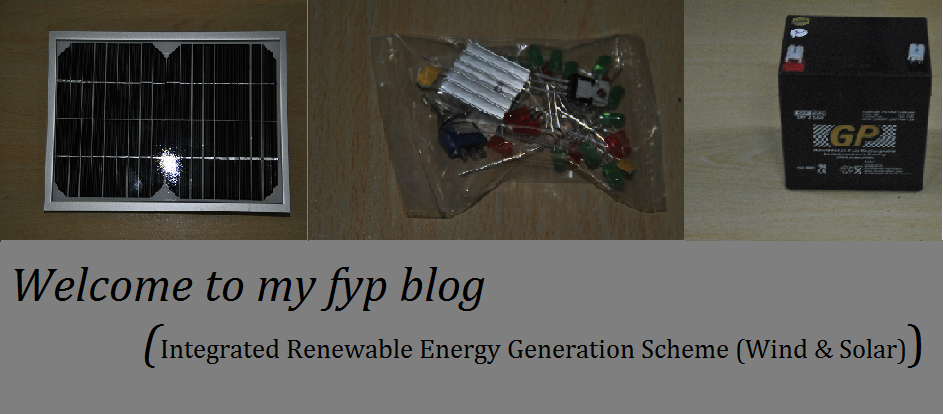
Tuesday, April 24, 2012
Sunday, April 22, 2012
Week 13
Sunday, April 8, 2012
Week 10
Calculation of Solar energy:
This the example of calculation for the solar energy that was estimate the value:
One solar panel of 150W/24V produce between 150W x 4h = 600 Wh and
150W x 6h = 900 Wh.
One battery of 12V/110Ah has a capacity of 12V x 110Ah = 1320 Wh
For technical reasons, it is not recommended to empty a battery more than 70%. The usable
capacity of this type of battery is around 924 Wh, what match to the produced electrical
energy of 600Wh to 900Wh.
We are offering 24V-systems, using 2 batteries with 12V/110Ah.
Using an inverter 24V to 230V connected to the batteries, it is easily possible to get a
power source of 230V, driving different types of electrical appliances like a fan, energy
saving lamps or a television.
There are different types of inverters. The type of inverter advised has an output of
pure sinus. Using them will avoid troubles that can occur on critical devices like television or
personal computers. If the inverter has a modified sinus output or (worst case) a rectangular
output, a significant part of the stored electrical energy will be wasted, and on long-term
running critical devices may damage.
With the stored power of 600 Wh to 900 Wh (one solar panel, see example above), it is
possible to use the following devices:
- 4 energy saving lamps 11W, time of use 4-6 hours (4x 11Wx 4h = 176 Wh)
- 1 fan 75W, time of use 3-5 hours (1x 75Wx 3h = 225Wh)
- 1 television 100W, time of use 2-3 hours (1x 100Wx 2h = 200Wh)
Total consumption = 601 Wh
So recommend the usage of two solar panels to get a buffer capacity in case of less sun.
This the example of calculation for the solar energy that was estimate the value:
One solar panel of 150W/24V produce between 150W x 4h = 600 Wh and
150W x 6h = 900 Wh.
One battery of 12V/110Ah has a capacity of 12V x 110Ah = 1320 Wh
For technical reasons, it is not recommended to empty a battery more than 70%. The usable
capacity of this type of battery is around 924 Wh, what match to the produced electrical
energy of 600Wh to 900Wh.
We are offering 24V-systems, using 2 batteries with 12V/110Ah.
Using an inverter 24V to 230V connected to the batteries, it is easily possible to get a
power source of 230V, driving different types of electrical appliances like a fan, energy
saving lamps or a television.
There are different types of inverters. The type of inverter advised has an output of
pure sinus. Using them will avoid troubles that can occur on critical devices like television or
personal computers. If the inverter has a modified sinus output or (worst case) a rectangular
output, a significant part of the stored electrical energy will be wasted, and on long-term
running critical devices may damage.
With the stored power of 600 Wh to 900 Wh (one solar panel, see example above), it is
possible to use the following devices:
- 4 energy saving lamps 11W, time of use 4-6 hours (4x 11Wx 4h = 176 Wh)
- 1 fan 75W, time of use 3-5 hours (1x 75Wx 3h = 225Wh)
- 1 television 100W, time of use 2-3 hours (1x 100Wx 2h = 200Wh)
Total consumption = 601 Wh
So recommend the usage of two solar panels to get a buffer capacity in case of less sun.
Sunday, April 1, 2012
Week 9
Calculation of wind turbines:
For this semester final year project,this wind turbines can't be done.Below are the calculation for wind turbines that was estimate the value.
For this semester final year project,this wind turbines can't be done.Below are the calculation for wind turbines that was estimate the value.
If you have a small wind turbine with a blade diameter of 1 m (about 3 ft) and an operating efficiency of 20% at a wind speed of 6 m/sec (about 13.4 mph). Then, to calculate how much power the turbine can generate at this wind speed:
Rotor swept area: Area = Π × (Diameter/2)2 = 3.14 × (1/2)2 = 0.785 m2
Available power in the wind: Pwind= Air Density × Area × v3/2 = 1.2 × 0.785 × 63/2 = 101.7 watt
Then the power that can be extracted from the wind assuming 20% turbine efficiency is:
Pturbine=0.20 × 101.7 = 20.3 watts
Pturbine=0.20 × 101.7 = 20.3 watts
If this ran continuously for a year (about 8,750 hours) then it would produce: 20.3 watts × 8,750 hours = 177,625 watt-hours, or about 177 kWh in a year.
Used the density of air at sea level, which is about 1.2 kg/m3
Subscribe to:
Posts (Atom)





